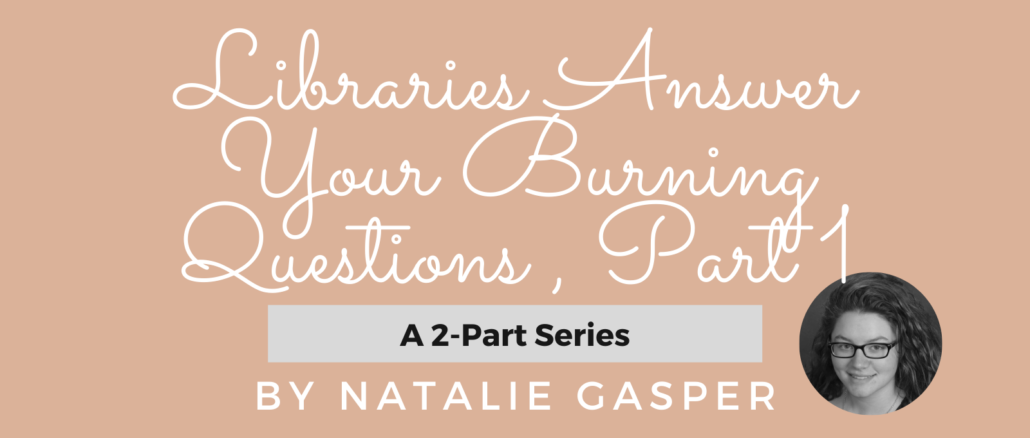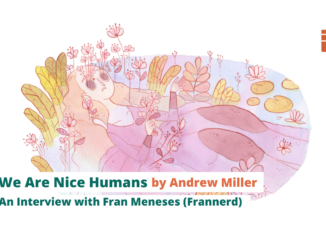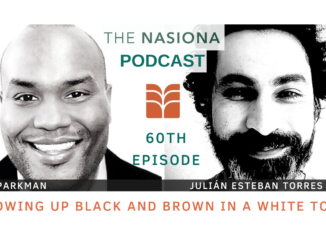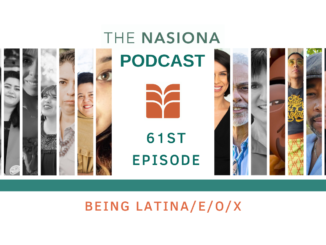
In this 2-part series, we asked libraries across the United States to answer some of your burning questions. In Part 1, we asked them:
- Do you have a book-buying budget? If so, does it fluctuate from year to year? Is it based on department/type of book?
- How do you find and choose which books to buy?
(Read Part 2 here.)
Do you have a book-buying budget? If so, does it fluctuate from year to year? Is it based on department/type of book?
Indiana: Indianapolis
Yes, I am part of a team of 5 collection development librarians in our technical services division. I select adult non-fiction material in print and electronic formats. Another does the same for adult fiction, another for all juvenile material, another for teen material, dvds, and music cds, and finally one for electronic resources such as database subscriptions.
- Budgets assigned to all five of us are established yearly, and fluctuate based on usage, predicted demand, affordability, and other considerations that help promote overall strategic plan goals.
- Within my funds I have separate amounts for books, physical audiobooks, world language materials, large print books, electronic books, and electronic audiobooks. The amounts dedicated to each section are subject to all the considerations mentioned above. Adult non-fiction print is by far my largest single budget line.
Louisiana: Caddo Parrish
Yes, our library system has a Materials Budget that we generally divide into four areas – books, A/V materials, periodicals, and online resources/databases. We then divide the Books budget into the categories of Adult (Fiction/Nonfiction), Juvenile (Fiction/Nonfiction), and Young Adult (Fiction/Nonfiction). The total of each of those budgets is then divided into spending goals for 21 branches in the library system. The Materials Budget can fluctuate from year to year, and the amount we spend in each area can vary depending on what our libraries and patrons are requesting.
Georgia: Live Oak
Yes, we have a book buying budget. The budget may fluctuate depending on monies received from the three counties we served and monies from Georgia Public Library Service.
Our Collection Management budget is broken down by format and audience.
- Adult print – fiction, nonfiction and large print – 39% budget allocation
- YA – fiction and nonfiction – 18%
- DVD – adult and children – 7%
- Audiobooks – adult and children – 7%
- E-books – adult and children – 23%
Arizona: Scottsdale
We do have a book buying budget and a portion of it is allotted to purchasing books by local authors. The budget allotments basically stay the same from year to year, percentage wise, though our collection management team analyzes circulation trends and adjusts the budget as needed.
This year, slammed by the pandemic, our purchasing budget for all materials, physical and digital, has been reduced by over 75%, so all purchases are being considered carefully.
Rhode Island: North Kingstown
We do have a book-buying budget, but because the library is very, very small and funded by community fundraising to a pretty huge extent, we often find that we can’t take too many risks in what we buy for the collection.
This means that almost all of what we buy is material that we know will circulate — James Patterson, Elin Hilderbrand, Stuart Woods, etc. The budget isn’t divided up by department, as our staff isn’t divided that way and so it’s more practical just to keep it all together. The majority of our budget is spent on adult fiction, which is what circulates the most by a wide margin. The second biggest expenditure is probably in juvenile fiction and picture books.
The budget doesn’t fluctuate as much as you would think given the unreliability of our funding sources. We tend to scrimp and save in other areas, like programming or supplies, before we cut back on materials.
Maryland: Harford
Yes, we have a book-buying budget and that budget includes all formats including print, eBook, and audiobook. The budget is prepared yearly and allocated depending on publishing patterns, trends, new initiatives, and more. We closely monitor our customer borrowing and make adjustments as reading habits change, school assignments change and more. It is based on book genre, age appropriateness, subject, etc.
Wyoming: Carbon
We do have a book budget (or more accurately, “materials”), and it does indeed fluctuate from year to year. In our own system, the materials budget is 95% grant-funded, so you can imagine how that might change in any given year. Generally speaking, we don’t split the materials budget up into specific collections (ie: 45% for Children’s materials, 20% for nonfiction, etc), but we are a fairly small system and I’m sure others do this.
Massachusetts: Boston
We do have a book buying budget. Each year we look at the previous year’s collection usage/circulation and spending to determine how much we would like to spend on each format/age level (i.e., are we going to decrease the physical AV budget as more patrons discover streaming; did we over or under budget for Teen books the previous year?). We will move budgeted money between types of material, particularly at the end of the year. We break out the budget by Adult print books (but not fiction versus nonfiction), Children’s books, Teen books, Languages, streaming media, and physical media.
Florida: Orange
Yes, we have a book budget and it does fluctuate from year to year. The book budget is divided into various categories – adult/juvenile, fiction/nonfiction, etc. and is based on usage statistics and book pricing. Currently, adult non-fiction is slightly higher than juvenile non-fiction.
Minnesota: Carver
We have a collection budget which is divided by type (book, electronic, and AV) then within each of those divided by areas (adult fiction, juvenile graphic novels, etc). We spend a little more on adult books since they tend to create hold lists where kids books do not. We are, because of COVID, putting a lore more money that originally budgeted for electronic materials and taking from the other two budgets.
New Mexico: Santa Fe
We do have an annual budget for both electronic resources and books as well as physical items. We base it on circulation rate of different topics. In general, libraries tend to spend more on adults than children because of space issues and more on fiction than nonfiction because of popularity and circulation rates.
Pennsylvania: Adams
Our book budget does fluctuate a little year to year but we do have to spend `12% of our budget on collection materials per PA public library laws. The total collection amount is divided between children, young adult, and adults, and then split between the types of books into individual ordering lines for the year. Different professionals from across our 6 library locations orders materials for the entire county and usually has one subject/sections/age group to purchase for. We use professional public library ordering companies mentioned below because the items are reviewed.
Utah: Salt Lake City
The library has a materials budget that is then divided across the projected needs of the selectors. The budget does fluctuate from year to year, based on demand, availability of funds, size of the population served, etc. Over the past couple of years, the budget for ebooks and eaudiobooks has grown rapidly and substantially, so that particular budget has increased. The budget for an item like books on CD has gone down each year as the technology becomes less prominent.
California: Alameda
As part of the library’s budgetary allocation process, funds for purchase of library resources are allocated to the Technical Services Department to purchase materials for Libraries. Some additional materials are purchased through grant funding. For this fiscal year that began on July 1, 2020, we were allocated a certain dollar amount for materials in all formats (books, eBooks, magazines, DVDs, etc.) We allocate money from this budget to materials by age level and format. Precisely, we divide this money into micro-budgets. These allotments are based on spending history, demand, equity, and need. Budgets do fluctuate based on factors such as tax revenue projections and the Library’s overall spending priorities.
Virginia: Arlington
Yes, we have a materials budget that includes books and “book-like objects” – ebooks, audiobooks, eaudiobooks, etc. The budget has been stable overall for the past few years. Within the materials budget individual sections might fluctuate from year to year based on the library’s strategic priorities and the needs of the community. For example, ebooks’ share of the budget has increased over the past ten years due to changing reader habits, and the need for children’s books has increased in some branches as more families in those neighborhoods have become active library patrons.
Florida: Miami Dade
Yes. We have an annual library materials budget that is used for purchasing the physical and digital content that is made available for our patrons, whether it be books or other materials on the shelves in a physical library location or in digital form on one of our e-book/e-audiobook third party platforms or various digital learning/research products that can be accessed online or through our mobile app.
Massachusetts: Fall River
Yes, we have an annual book budget, which fluctuates from year to year depending on the total budget, but must be a certain proportion of our total spending. Within that, we have amounts allotted for adult, young adult, and children’s, but we can be somewhat flexible with this–for example, if we needed to update a certain subject area in children’s one year.
New York: Queens
The Queens Public Library funding comes mostly from the City through the Mayor and City Council’s budget. We dedicate millions to print and digital resources every year on new materials, re-orders, databases and other online resources in a variety of languages. The materials we acquired spread across all age groups.
Alabama: Gulf Shores
I do have a book budget, it doesn’t usually fluctuate much from year, but I do get to put in a request to change it up or down annually if I feel like I need to. It’s all one big pool of money and I have several employees who order within their specialty, but we don’t have a set limit for each category, we just mostly buy bestsellers or things we think our patrons would like to read or have requested (adult and children, movies, audio books, e-books, etc.).
Maryland: Carroll
We do have a budget for materials, both print and non-print, as well as e-materials and research databases. We evaluate our circulation for materials in all categories on a regular basis and budget accordingly. We strive for a well-balanced collection but focus primarily on providing the newest materials that are popular with our customers.
Texas: Austin
Yes, the Austin Public Library has a designated budget for book purchases. The budget fluctuates in response to community needs and available funding. Asset allocation is generally based on usage factors to help meet patron demand.
North Carolina: Catawba
Our library does have a book budget that fluctuates slightly year over year depending on usage and budget amounts. We try to base our budgets on user demand looking at circulation and interests.
Michigan: Ann Arbor
Our materials budget is approx 1.8M, and it has fluctuated very little in the past five years.
New Hampshire: Hudson
Generally each dept. has its own budget i.e. teen, nonfiction, children’s etc., which does fluctuate.
How do you find and choose which books to buy?
California: Alameda
Materials selection is the heart of the collection development process. Skill, knowledge, and the proper tools are necessary to make decisions that will accurately meet community needs. The library strives to balance current, high-demand materials with those of proven, long-term interest. The library also must balance recreational materials with informational, educational, and cultural materials.
Anticipated demand, the interests of Library members, media attention, subject need, and member requests may be used in making selection decisions. We also consider the need to provide choices of format, level of difficulty, treatment, and diverse points of view on a given topic. We pay particular attention to resources not usually available to the general consumer. These can include independently published materials, educational videos, reference information, homework support, electronic materials, and well-selected recreational fiction beyond the bestseller.
Librarians apply their judgment and experience in selecting resources according to the general criteria listed below. All criteria do not apply to each selection. Works of fiction are judged differently than works of non-fiction. Librarians consult reviews and other evaluative sources, and generally demand takes precedent. We work with several wholesalers who regularly provide us lists of upcoming new titles across age levels and formats. They can provide us with specialized lists in various subject areas to help us keep our collections current and relevant. We also closely follow cultural trends and developments and order books to meet immediate needs and interests. Right now, we are constantly looking for books on racism and that emphasize diversity of experience, especially for children.
The general criteria listed below apply to all age-levels and formats. The sequence of these criteria is not necessarily an indication of their relative importance.
- Relevance to diverse populations served by the Library
- Current and historical significance/document of the times
- Critical praise/notice/literary merit
- Usefulness
- Appropriateness of format
- Space and budgetary considerations
- Reputation/importance of the author/artist
- Collection balance/minority point of view
- Value of resource in relation to cost
- Local interest (subject, author, publisher)
- Relationship to the existing collection
- Currency of information
- Readability/appropriateness for audience
- Reviews from reputable resources
Florida: Miami Dade
National bestsellers are of particular interest to our patrons, but, at the library branch level, our Librarians work closely with patrons that visit their branches and receive a great deal of input from them about their interests, preferred formats, etc. The individual branches will place orders for materials they believe will meet the needs of their patrons.
We also have a Suggestions for Purchase system that allows patrons to identify items of interest that we do not have, with the intent being that we will try to purchase those items if they are appropriate for our collection and of potential interest to other patrons. We also look at publisher reviews and utilize collection improvement software to assist us with selecting, evaluating, and managing our collection.
Indiana: Indianapolis
I utilize a several different resources, which I will list shortly, but my primary tool for book acquisition is Edelweiss (https://www.edelweiss.plus/). I set my publication date target to 60-120 days from when I run the search for adult non-fiction books, which generates a list of thousands of ISBNs that I then import into my main book vendor, Baker and Taylor.
From Edelweiss and Baker & Taylor I get more options than I have funds, so it is a matter of removing the items that I judge least likely to be of interest to my patrons. This is easily 90%+ of my total expenditures. “Judgment” is informed by looking at both the outside world (bestseller lists, books about to become movies or on Netflix) and internal library usage data (my patrons love biographies, cookbooks, and health information).
Libraries organize non-fiction along the Dewey Decimal system (https://en.wikipedia.org/wiki/List_of_Dewey_Decimal_classes) and over time selectors slowly develop a feel for which classes they can order more heavily in, and which classes where they don’t need to spend as much. I started by ordering everything in small amounts, and running reports on which items had the most hold requests placed by patrons. Other resources include:
- Midwest Tape, audiobook vendor. They provide newsletters and their catalog can be search by sales ranking and audience.
- African American Intellectual History Society. I subscribe to their newsletter for information about books that meet a strategic plan priority (increasing representation and diversity).
- Publisher’s Weekly – book reviews and publishing industry information, read weekly.
- Booklist – reviews, check out https://libguides.ala.org/marketing-to-libraries.
- Arts & Letters Daily blog, book reviews
- largehearted boy blog – compiles best-of end of year lists so I don’t have to. (example: http://www.largeheartedboy.com/blog/archive/2019/10/online_best_of_78.html).
- Book Pulse, from Library Journal – newsletter with reviews and awards.
- Foreword reviews – more book reviews.
- My local newspaper – the Indianapolis Star.
- Other stuff I’m forgetting.
Virginia: Arlington
We have a team of selectors, all librarians with master’s degrees in library science. Using our material selection policy as an overall guide, they add over 60,000 items to our physical collection each year (and even more when you add in the e-collection). They use reviews from professional journals, website reviews, newspaper reviews, magazine reviews, podcasts, radio … there’s a wide variety of review sources that they consult to help them make decisions. They also take suggestions from the community and spend a lot of time watching community engagement and seeing which titles resonate with the patrons and community.
Massachusetts: Boston
We use a variety of sources – we look at professional reviews sources, blogs and non-professional reviews our patrons may read, our vendors work with publishers to send lists of forthcoming books which they expect will be popular, we have standing order profiles for popular authors, librarians will look for new titles in specific subjects that support our research collections, and we take requests directly from patrons and will try to buy materials that they are asking for. We use sites like Goodreads and social media to try to predict how popular a title will be pre-pub, and how many copies we should buy for our library system. We also look for and purchase titles to replace existing item or update subjects.
Utah: Salt Lake City
I use a lot of different sources, but patron demand comes first whenever possible. When people request items, it’s a great chance to buy with no guessing involved—the people have spoken! Outside of patron requests, I use a variety of professional library newsletters, journals, websites, podcasts, and magazines to see what is on the horizon, and what readers and publishers are buzzing about. It’s important to have what’s popular, but also to make sure there are no giant subject gaps in the collection. If there was no current demand for philosophy books, for instance, I couldn’t ignore the philosophy collection, I just wouldn’t be able to prioritize it in the way I might need to prioritize something like a popular political book during an election year, or something that had dozens of requests on it.
New York: Queens
We have a dedicated and knowledgeable team of librarians who work with large and small publishers and vendors to acquire those titles that meet the needs and wants of our customers. They use professional reviews, data provided by publishers, such as initial print run, subject covered, to make selections. Recommendations from other staff as well as the customers are also welcomed.
Massachusetts: Fall River
Most of our books are purchased through Ingram, and we have some standing orders set up with them (i.e., NYT Bestsellers). They also provide monthly catalogs with advance listings. Other publishers and distributors also send us catalogs. In addition, we subscribe to print journals such as Library Journal and Horn Book which review adult and children’s titles, and I follow online book blogs and library lists such as Book Riot and LibraryReads to find out about new titles. Other sources are suggestions from patrons and periodic review and updating of our current collection.
New Mexico: Santa Fe
We do have standing orders for popular authors and series, i.e. James Patterson, Lonely Planet, etc. Our purchasing is done through a national vendor. The librarians search new and upcoming titles and research the reviews of publishing journals to see if they meet our Collection Development Policy. Our librarians look at book reviews and topics to assess the value of adding a title to our system.
Rhode Island: North Kingstown
As I mentioned, most of what we buy is from authors whose works are popular. As a result, we just try to keep up on which authors have books coming out and select books that way. However, if there are books that are receiving buzz in the media or are well-reviewed in trusted outlets, such as Kirkus or the NYT, we’ll pick those up in anticipation of their popularity. We will also occasionally check system-wide holds to see if there are books we don’t already have that are in demand at other libraries in our consortium.
Maryland: Carroll
We use professional review journals like Publisher’s Weekly, Booklist, Library Journal and School Library Journal but we also use the websites of book wholesalers like Ingram, Baker and Taylor and Brodart. We look at popular culture magazines as well. We purchase award winning titles, independent publisher titles, and we support local authors. We include authors from all ethnic backgrounds and lifestyles.
Wyoming: Carbon
We buy books largely according to whatever the algorithms at our supplies tell us to, and then add a few local authors or local interest items on top of that. Most public library systems purchase their books (at a significant discount from retail) from large suppliers like Ingram or Baker&Taylor, and these suppliers create lists of authors and subjects that we automatically purchase on a rolling basis throughout the year.
North Carolina: Catawba
Our collection development team is split up in the genre or Dewey categories to conduct collection development. We purchase professionally reviewed titles that we feel will supplement our collection ensuring that our patrons have access to the most up to date and authoritative resources.
Georgia: Live Oak
We have created profiles with our vendors. What does this mean? We receive on a monthly basis a curated list. These lists are then put into a cart (i.e. Live Oak Adult 100 (date of the cart)). In this cart, I will find titles that are in the Dewey number in the 100’s. We also received carts or lists with titles that will be published 3 to 4 months in advance. We also use Publisher’s Weekly, The New York Times Best seller list and our own collection analysis tool.
Louisiana: Caddo Parrish
Our Acquisitions Librarians will look at various library journals and newsletters (Publishers’ Weekly, Kirkus Reviews, School Library Journal, etc.) as well as our vendor websites for purchase suggestions. We also listen to our branch staff to see what patrons want to read and are requesting.
Florida: Orange
We look at several different sources:
- Review publications such as Library Journal, School Library Journal, Publisher’s Weekly
- Publisher web sites and catalogs
- Library vendor web sites
- Publisher, publishing industry and library industry webinars
New Hampshire: Hudson
There are multiple sources for finding including bestseller lists, standing orders, book reviews, word of mouth and magazines. We look at what topics have been circulating and order newer books in those categories or formats.
Texas: Austin
Libraries rely on official collection development policies that include specific purchasing criteria. Criteria generally includes positive review(s) in professional journals, major literature award winners, and item popularity.
Maryland: Harford
The Materials Selectors use reviews and professional journals to make selections. In addition, our vendors prepare suggested lists of future published items that they also review and make selections. In addition, our selectors stay on top of current trends by reading popular magazines and scanning online. Often a customers may submit a title request and the library will purchase for our collection.
Arizona: Scottsdale
We choose the bulk of our purchases from vendors who not only supply materials, but send them to us prepared with bar codes and ready to shelve. We do buy a portion of our books from other vendors, as needed. We have a team of librarians curating selections for different genres and types of books.
Minnesota: Carver
Mainly reviews. We use some publishers’ catalogs and some lists produced by our book vendor Brodart. I mainly use those lists for the areas I select in. Those lists sometimes contain small publisher, but rarely self-published.
Pennsylvania: Adams
Almost specifically from public library related sources/warehouses. It is 99% from Ingram for book purchases and 100% Midwest Tapes/Blackstone Audio for a/v products.
Michigan: Ann Arbor
We have selectors on staff working in our Collections department who select and manage the budgets for all of our materials.
Alabama: Gulf Shores
We have many of our authors on standing order and we read reviews in Bookpage and other resources like suggested lists from Baker and Taylor, etc.
INTERVIEWER
Natalie Gasper is an internationally performed poet whose work has appeared in The Write Launch, The Hickory Stump, Sheila-Na-Gig, Noon by Arachne Press, and ellipsis…literature & art, amongst others. She works as an interviewer for The Nasiona and is a developmental editor for Envie, a Magazine for the Literary Curious.




3 Trackbacks / Pingbacks
Comments are closed.